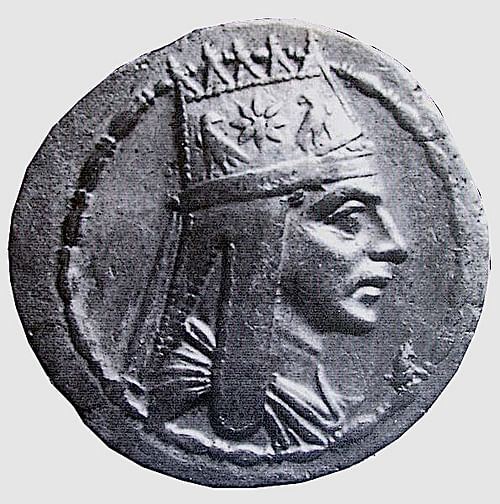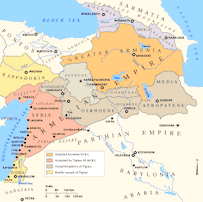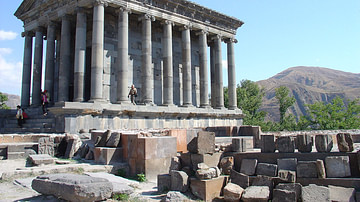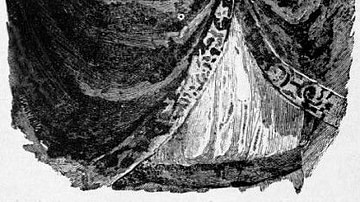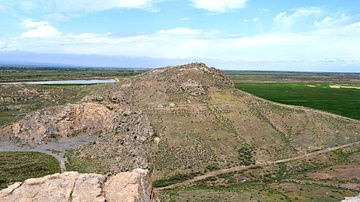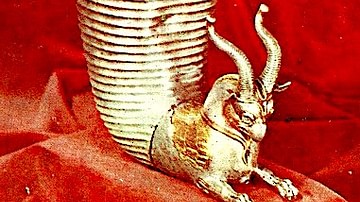
The Artaxiad (Artashesian) dynasty ruled ancient Armenia from c. 200 BCE to the first decade of the 1st century CE. Founded by Artaxias I, the dynasty would ensure Armenia enjoyed a sustained period of prosperity and regional importance. One of several important Artaxiad rulers was Tigranes the Great, who greatly expanded his kingdom before its ultimate defeat to the Romans in the mid-1st century BCE. Thereafter, the kingdom would become a pawn in the wider politics and wars involving Rome and Parthia.
Decline of the Orontid Dynasty
The Orontid dynasty had ruled ancient Armenia as Persian satraps from the 6th century BCE, then they had governed under the suzerainty of the Macedonians and the Seleucid Empire following the region's conquest by Alexander the Great in the latter half of the 4th century BCE. The last of the Orontid dynasty to rule in eastern Armenia was king Orontes IV (to the Armenians, Yervand IV or Yervand the Last, r. c. 212-200 BCE). Yervand, who, like many of his predecessors, had given himself the title of king, moved the capital from Armavir to the newly founded Yervandashat, meaning “Yervand's Joy”. Around 200 BCE Yervand IV was murdered and Artaxias I (aka Artashes or Artaxerxes), backed by the Seleucid ruler Antiochus III (r. 222-187 BCE), was made the empire's satrap in Armenia. Contrary to the traditional view initiated by ancient authors, it seems likely that the Orontid and Artaxiad rulers did share a common ancestry as revealed by name conventions and recently discovered inscriptions on Armenian boundary stones.
Artaxias I
Antiochus probably thought a change of regime would reduce the increasing trend of Armenian independence from Seleucid overrule. To this end, he created two satraps: Artaxias in Armenia and Zariadris in Sophene to the southwest. However, when Antiochus was defeated by the Romans at the Battle of Magnesia in 190 BCE, Artaxias declared himself king and set about expanding his kingdom, first by marriage to Queen Satenik of Asian Iberia. Artaxias conquered part of Media Atropatene north of the Arax River while in the south, the areas of Phaunitis and Armenian Siunik, and in the west, Vaspurakan, were annexed. The kingdom was unified as never before with an administrative centralisation and such innovations as boundary stelae to proclaim property rights and the authority of the crown. No wonder, then, that Artaxias has become one of the most revered of all Armenian kings and the subject of poems and songs ever since his reign.
A new capital was founded on a peninsula of nine hills at Artaxata (Artashat) in 176 BCE. Hannibal, the great Carthaginian general, was said to have designed the city's fortifications when he served Artaxias following his defeat to the Romans. These and other features of the city are described by the historian R. G. Hovannisian:
The city contained a citadel on the height later called Xor Virap (Khor Virap) and was protected by extensive fortifications and a moat. Recent excavations have a revealed a major urban center with paved streets, public buildings, baths, shops, and workshops of various craftsmen…it rapidly became a major junction point between the trade route along the valley of the Araxes leading outward to Bactria and India and the one running northward to the Black Sea. (49)
Artaxias' long reign finally came to an end sometime between 165 and 160 BCE but his line continued with his two sons, first with the brief reign of Artavasdes (Artawazd) and then Tigranes I (Tigran I), whose succession date is unknown and who would rule until 95 BCE. Not much is known about either ruler beyond a few excavated coins corroborating their existence which previously had been suggested only by the appearance of their names in a few ancient texts.
Tigranes II the Great
After a rather dim period in the historical record for Armenia, a shining light suddenly arrives on the scene with a mass of documentation covering the greatest of Artaxiad kings, or indeed any Armenian king, Tigranes II (Tigran II) or Tigranes the Great (r. c 95 - c. 56 BCE). He was put upon the throne of Armenia by the Parthians after his uncle, the Armenian king Artavasdes I, had been forced to send Tigranes as a hostage to them. When his father Tigranes I died c. 95 BCE, Tigranes was sent back to Armenia to take his place on the throne. The new king had to cede the “Seventy Valleys” to the Parthians (a territory probably towards modern Azerbaijan) although he soon proved to be anything but a compliant client ruler.
Tigranes took advantage of the Parthians being distracted by invasions on their eastern borders and set about expanding his own kingdom even further. First, he annexed the other part of traditional Armenia, the kingdom of Sophene, in 94 BCE. With formidable siege engines and units of heavily-armoured cavalry, he then re-took the “Seventy Valleys” and conquered Cappadocia, Adiabene, Gordyene, Phoenicia and parts of Syria, including Antioch. The Armenian king even sacked Ecbatana, the Parthian royal summer residence, in 87 BCE while the Parthians were struggling to deal with invading northern nomads. At its peak, Tigranes the Great's Armenian Empire stretched from the Black Sea to the Mediterranean. Not before or since would Armenians control such a huge swathe of Asia.
From 85 BCE Tigranes rather grandly began calling himself the “King of Kings”, although the title is further evidence that he left conquered monarchs to rule as vassals. The conquered states were obliged to pay tribute and populations were relocated to reduce dissension and increase loyalty wherever required. Tigranes was noted as an admirer of Greek culture and the capital city he founded in 83 BCE, Tigranocerta (aka Tigranakert, and of uncertain location), was famously Hellenistic in its architecture. The Greek language was likely used, along with Persian and Aramaic, as the language of the nobility and administration while commoners spoke Armenian. Persian elements continued to be an important part of the Armenian cultural mix, too, especially in the area of religion
Tigranes then made his major political blunder and allied himself with Mithridates VI, the king of Pontus (r. 120-63 BCE) and great enemy of Rome. Admittedly, Tigranes was married to Mithdradates' daughter Cleopatra and, really, it seemed that whichever side Armenia chose - Rome or Parthia - the small kingdom caught between these great empires would always come off second best.
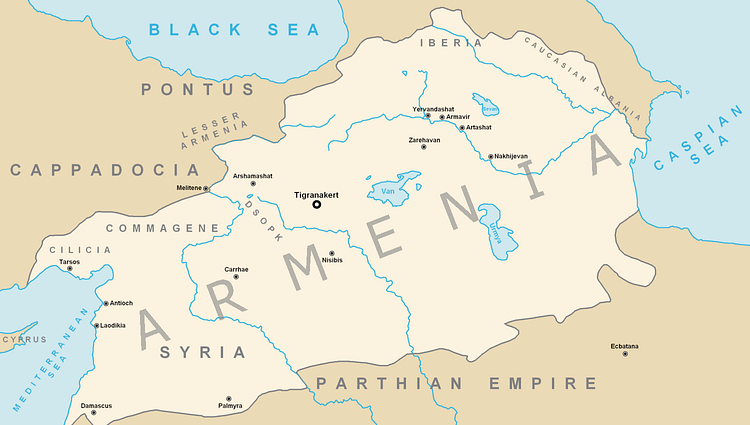
The Roman Republic, seeing the danger of such an alliance between the two regional powers, responded by attacking Pontus and when Mithridates fled to the court of Tigranes in 70 BCE, the Romans invaded Armenia. Tigranes was defeated by a Roman army commanded by the general Licinius Lucullus, Tigranocerta was captured in 69 BCE and the Armenian king was forced to abandon his conquests. Following another Roman attack c. 66 BCE, this time led by Pompey the Great, Armenia was made into a Roman protectorate. Thereafter, the state became a bone of contention between Rome and Parthia (and its successor, Sasanid Persia) but Tigranes continued to rule most of Armenia as a vassal state of the Roman Empire which acted as a useful buffer to the Parthians until his death c. 56 BCE aged 85.
Rome, Parthia & Decline
Artavasdes II (r. c. 56 - c. 34 BCE), son of Tigranes II, was known as a philosopher king because of his literary works in Greek, none of which, unfortunately, survive. Armenia continued its precarious position between the Roman Empire in the west and Persia in the east. The Roman general Marcus Licinius Crassus obliged Artavasdes to support his campaign against the Parthians in 53 BCE but following its spectacular failure, when the richest ever Roman lost both his army and his head, an alliance was re-formed between Armenia and Parthia and cemented by Artavasdes betrothing his sister to the eldest son of the Parthian king Orodes II (r. 57-37 BCE).
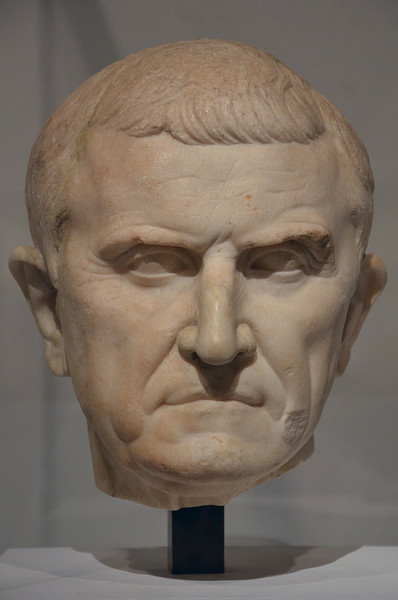
However, in 36 BCE, the region was again destabilised when another Roman general, this time Mark Antony, passed through, and the Armenians were, once more, asked to provide troops. Once again, the Romans were defeated by their nemesis the Parthians. In 34 BCE Antony then moved against the Artaxiads, taking Artavasdes to Alexandria where the flamboyant triumvir controversially celebrated an unofficial triumph for his victories in Armenia. Artavasdes would later be executed by Queen Cleopatra.
Meanwhile, the Parthians installed Arteses (Artashes) II as king of Armenia in c. 30 BCE, one of the sons of Artavasdes. Then, in 20 BCE, Rome reasserted its claim over the region when Emperor Augustus sent Tiberius to reinstall a king of Armenia who was more loyal to imperial Rome: Tigranes III. In a game of musical thrones, the Parthians installed Tigranes IV in 8 BCE, who was then briefly replaced by the Roman-backed Artavasdes III in 5 BCE, before regaining his seat in 2 BCE, although this time he had to share it with his sister Erato. Three more changes would occur over the next decade but the music was about to stop for good.
The volatile political reality of the region in this period is reflected in the short reigns and frequent change of subsequent monarchs: nine rulers up to the first decade of the 1st century CE. The decline of the Artaxiads was also in part due to the internal factions which had been created by the nobility splitting into either pro-Roman or pro-Parthian factions. In unclear circumstances, the Artaxiads were succeeded by the next dynasty to dominate Armenian affairs, the Arsacid (Arshakuni) dynasty, when their founder, Vonon (Vonones) took the throne in 12 CE.
This article was made possible with generous support from the National Association for Armenian Studies and Research and the Knights of Vartan Fund for Armenian Studies.
